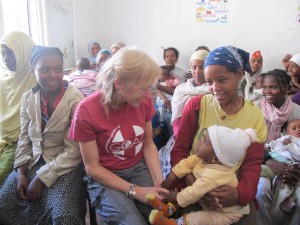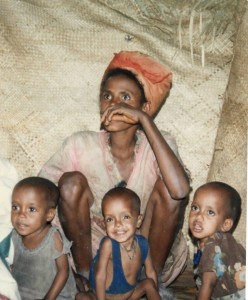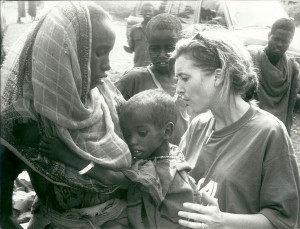Maura Lennon’s return to Ethiopia with GOAL
Maura Lennon is living proof of the folly of rash categorisation. She is a petit woman, who looks anything but her 48 years: despite most of those years having been spent working in some of the most trying circumstances imaginable.
Hers is a bubbly personality: but it masks the steely determination necessary for the selfless, sometimes hazardous career she has pursued since early adulthood.
It all began in 1985, when, as a 21-year-old newly-qualified nurse, Maura joined GOAL for a six-month spell in Ethiopia, to help the victims of a catastrophic famine that cost nearly one million lives. Her planned six-months stay in Ethiopia stretched to two years, broken only by a Christmas fortnight at home.
And her career with GOAL has lasted for 27 years, during which time she has served in numerous countries across the developing world. Now living in Galway, Maura is the organisation’s representative for the West of Ireland.
Twenty-seven years after the terrible famine, Maura Lennon returned to Ethiopia last week to visit GOAL’s programmes there, anxious to see how things have changed in the intervening years.
How does she feel about being back? “Nervous, excited and emotional: but also delighted by the many positive changes since 1985.”
Unfortunately, there are some things that seem destined never to change in parts of the Horn of Africa, where Ethiopia is situated.
“The other day, I visited the Dolo Ado refugee camps, which are home to around 150,000 mostly Somali victims of the latest famine in the Horn. The smell of human misery hit me straight away, and took me back to 1985. You can never forget that terrible stench. It stays with you forever, as anyone who has experienced it knows.”
As little more than a girl, Maura witnessed scenes during the famine that have lived with her ever since: “Effectively we had to play God, forced to decide who would live or die. There was only so much food for us to distribute to the people, and every morning starving families would queue outside our feeding centre. You had to turn people away, knowing that most of the rejected people wouldn’t be back, because soon they wouldn’t be alive. That’s a terrible responsibility, but we couldn’t leave avoid it.”
One mother presented Maura with a ring, which later became her wedding band: “She was so grateful that we could feed her children and save their lives, she gave me this ring. I’ve always treasured it. When I got married it became my wedding ring.”
Many equally grateful parents named their children “Maura” in lasting recognition of the little Irish nurse. “I haven’t met an Ethiopian Maura yet,” she laughs, “But I’d love to, so fingers crossed. The main thing though, whether I manage to meet one of them or not, is that they survived.”
Maura has four children of her own now, and parenthood has widened her perspective on the famine: “I grew up very quickly in Ethiopia, witnessing so many truly horrific things. But when you’re 21, you can’t be completely mature, no matter what you’ve experienced. The deaths of the children naturally devastated me. But it’s only now, as a mother, I can begin to appreciate what it must have been like for the poor bereaved parents.”
She was sometimes working on her own in remote villages for weeks at a time, with little or no means of communicating with the outside world. Mobile phones and emails were decades in the future. Back then, it could take six weeks for a letter to arrive from home.
“I was helicoptered in to do vaccinations, and then airlifted out again maybe three weeks later. It was lonely and frightening at times, waiting anxiously for the sound of the chopper coming back to lift you. That sort of thing would never be allowed nowadays.”
The food she took to sustain her in the villages was very basic – often only canned cheese and biscuits – and living conditions were even worse. “I remember staying in a mud hut on my own for a few weeks, with only a bat and a rat for company.”
Wherever she went, death was an ever-present: “I’m not a midwife, but once, as the only Westerner and medically trained person in a village, I was on a dirt track trying to save the life of a young mother and her newborn twins. Most of her neighbours and her poor husband were gathered around us, looking on. Both babies died, and then the mother died as well. That was heartbreaking, and I was a long time getting over it. She and her babies were just too weak and malnourished to survive. Some of the villagers were angry with me. They had invested so much faith in me being able to work a miracle, and felt I had let them down. Though I don’t think I was ever in any real danger.”
The problem with Maura Lennon is that the more you learn about her and the degree to which she has dedicated herself to the welfare of humanity, the harder it becomes to categorise her. Perhaps it’s precisely because the likes of her are so uncommon, that we use the (wholly inadequate) term “one in a million” to describe such people.
It certainly doesn’t do anything like full justice to Maura and her type, but as it’s the best we can manage, I suppose it’ll have to do.
David Williams
GOAL Media & PR Officer
Tel: 00 353 (0)1 280 9779
Mob: 00 353 (0)87 419 7140
Email: dwilliams@goal.ie
Skype: david.williams761
GOAL is an international humanitarian organisation
GOAL
PO Box 19,
Dun Laoghaire,
Co. Dublin
Ireland
www.goal.ie


